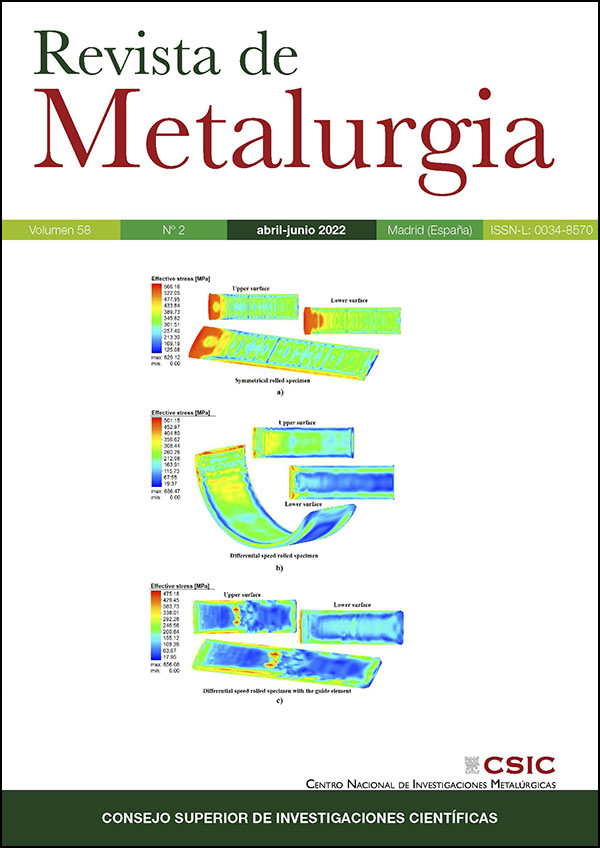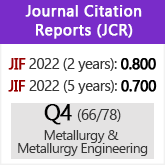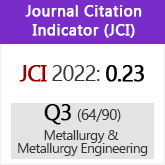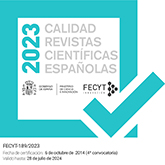On the application of the forming limit diagrams for quality control of blanks for wheelbarrow of ASTM A1008 carbon steel
DOI:
https://doi.org/10.3989/revmetalm.218Keywords:
ASTM A1008 carbon steel, Forming limit diagram, Plastic strain ratio, Quality control, Strain-hardening exponentAbstract
The effectivity of the forming limit diagrams in manufacturing wheelbarrow by deep-drawing is shown because of the high material scrap rate which reduces productivity. Several chemical, mechanical testing and microstructural analysis were performed to examine sheet quality and their impact on these diagrams. Chemical analysis revealed that Steel 1 and Steel 3 sheets fulfilled the specification without assuring adequate forming process. However, the higher titanium content of Steel 2 improved its formability since it promoted the formation of fine precipitates, thus refining the grain size. This steel had the highest ASTM grain size number G (9.11), which is the lowest average grain size (13 µm) compared to the other steels, which had G values in the range 8.7 to 9.11. Moreover, Steel 2 sheets had the greatest plastic strain ratio (rm = 1.80), the highest strain-hardening exponent (n = 0.250), the lowest anisotropy ∆r = 0.31), yielding better results in deep-drawing strain distribution, the highest forming limit strain (28%) and the highest uniform elongation zone, favoring that failure sites did not occur.
Downloads
References
ASTM E415 (1999). Standard test method for optical emission vacuum spectrometric analysis of carbon and low-alloy Steel. ASTM International, West Conshohocken, PA, USA, pp. 3-5.
ASTM E517 (2000). Standard test method for plastic strain ratio r for sheet metal. ASTM International, West Conshohocken, PA, USA, pp. 1-5.
ASTM A1008 (2010). Standard specification for steel, sheet, cold-rolled, carbon, structural, high-strength low-alloy, high-strength low-alloy with improved formability, solution hardened, and bake hardenable. ASTM International, West Conshohocken, PA, USA, pp. 1-9.
ASTM E643 (2015). Standard test method for ball punch deformation of metallic sheet material. ASTM International, West Conshohocken, PA, USA, pp. 1-4.
ASTM E2218 (2015). Standard test method for determining forming limit curves. ASTM International, West Conshohocken, PA, USA, pp. 1-10.
ASTM E646 (2016). Standard test method for tensile strain-hardening exponents (n-values) of metallic sheet materials. ASTM International, West Conshohocken, PA, USA, pp. 2-5.
ASTM E8 (2016). Standard test methods for tension testing of metallic materials. ASTM International, West Conshohocken, PA, USA, pp. 7-18.
ASTM E3-11 (2017). Standard guide for preparation of metallographic specimens. ASTM International, West Conshohocken, PA, USA, pp. 1-8.
Barbosa, J.E., García, I.H., Fuentes, J.J. (2009). Estimación vía experimental de la formabilidad de láminas de aluminio de pureza comercial. Rev. LatinAm. Metal. Mater. 29 (2), 128-134.
Davis, J.R. (2004). Tensile testing. Second Edition, ASM International, USA, pp. 251-257. https://doi.org/10.31399/asm.tb.tt2.9781627083553
Drittler, O.E., Gricus, F.V. (1978). Formability of aluminum alloys using cup tests. In Formability topics-metallic materials. ASTM STP 647, pp. 39-48.
Hosford, W.F., Caddell, R.M. (2011). Forming limit diagrams. In Metal forming, Mechanics and metallurgy. Cambridge University Press, Michigan, USA. pp. 245-262. https://doi.org/10.1017/CBO9780511976940.017
Hursman, J. (1978). Development of forming limit curves for aerospace aluminum alloys. ASTM International, pp. 49-64. https://doi.org/10.1520/STP30049S
Kohara, S. (2005). Influence of strain path on the forming-limit curve in aluminum. Metall. Mater. Trans. A 36, 1033-1037. https://doi.org/10.1007/s11661-005-0296-8
Korhonen, A.S., Manninen, T., Yoon, J.W., Larkiola, J. (2009). Comparison of forming and fracture limits of an aluminum alloy and austenitic stainless steel. Int. J. Mater. Form. 2 (1), 431- 434. https://doi.org/10.1007/s12289-009-0489-6
Lege, D.J. (1978). Predicting sheet anisotropy from fracture angle of tension specimens. ASTM International, pp. 86-99. https://doi.org/10.1520/STP30047S
Newby, J.R. (1978). Formability testing and deformation analysis of steel sheet. Armco Steel Corporation, Middletown, Ohio, pp. 4-38. https://doi.org/10.1520/STP30043S
Pearce, R. (1982). 4000 years of sheet metal forming. In Formability of metallic materials. ASTM STP 753. Eds., American Society for Testing Materials, pp. 3-18. https://doi.org/10.1520/STP28384S
Pearce, R. (1982). 4000 years of sheet metal forming. In Formability of metallic materials. ASTM STP 753. Eds., American Society for Testing Materials, pp. 3-18. https://doi.org/10.1520/STP28384S
Semiatin, S.L. (2006). Metalworking: sheet forming (ASM Handbook). Volume 14B, ASM International, USA, pp. 524-560. https://doi.org/10.31399/asm.hb.v14b.9781627081863
Shinge, V.R., Dabade, U.A. (2018). Experimental investigation on forming limit diagram of mild carbon steel sheet. Procedia Manuf. 20, 141-156. https://doi.org/10.1016/j.promfg.2018.02.020
Sipos, K., Martínez, J., Burgos, N., Pesenti, H. (1995). Aceros para embutido profundo: fabricación, caracterización, microestructura y texturas. Rev. Metal. 41 (Extra.) 58-63. https://doi.org/10.3989/revmetalm.2005.v41.iExtra.999
Tisza, M., Kovács, Z.P. (2012). New methods for predicting the formability of sheet metals. Production Process and Systems 5 (1), 45-54.
Published
How to Cite
Issue
Section
License
Copyright (c) 2022 Consejo Superior de Investigaciones Científicas (CSIC)

This work is licensed under a Creative Commons Attribution 4.0 International License.
© CSIC. Manuscripts published in both the printed and online versions of this Journal are the property of Consejo Superior de Investigaciones Científicas, and quoting this source is a requirement for any partial or full reproduction.All contents of this electronic edition, except where otherwise noted, are distributed under a “Creative Commons Attribution 4.0 International” (CC BY 4.0) License. You may read here the basic information and the legal text of the license. The indication of the CC BY 4.0 License must be expressly stated in this way when necessary.
Self-archiving in repositories, personal webpages or similar, of any version other than the published by the Editor, is not allowed.


















